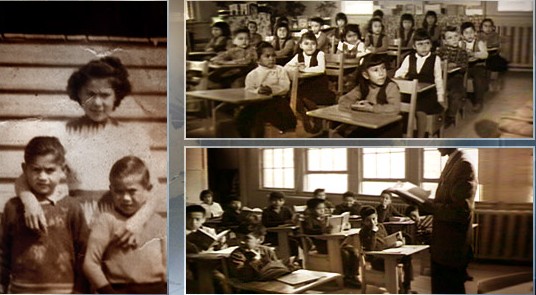
文字难度:★★★
When the welfare officers came to take three-year-old Archie Roach from his tin-lined house in 1)Framlingham in southeastern Australia, they told his mother they were 2)escorting him to a picnic. His aunt tried to 3)scare them off with a gun, but it wasn’t 4)loaded. Institutionalized in a Melbourne orphanage, young Archie was told his family had died in a fire. His 5)minders tried to force his hair straight, breaking comb teeth in his 6)frizzy curls. It was a vain attempt by whites to make an 7)Aboriginal child more like them. It didn’t work, and the combs weren’t the only 8)casualties.
Roach, now 54, is one of an estimated 100,000 Aborigines, living and dead, who make up Australia’s so-called Stolen Generation. At that time 9)Indigenous people were seen as an inferior race and those considered “not of 10)full blood” were encouraged to become 11)assimilated into the broader society so that eventually there would be no more Indigenous people left. Under a government policy that ran from 1910 to, unbelievably, 1971, as many as 1 in 10 of all Aboriginal children were removed from their families in an effort to “civilize” them by assimilation into white society.

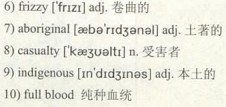
在澳大利亚东南部的弗莫林汉,福利院的官员从那铁皮屋里带走了当时只有三岁的阿奇·罗奇。他们对阿奇的母亲说是要护送他到一个野餐会去。阿奇的阿姨试图用枪吓走那些人,可是那杆枪是没上子弹的。小阿奇就这样被收容在墨尔本的一家孤儿院里,别人告诉他说他的家人已在一场火灾中丧生。他的看护人极力要把他的卷发梳成直发,结果弄到梳齿断裂。白种人以为如此一来就可以把土著居民的孩子变得和他们大致一样,却不过是白费心机。这样并不奏效,而遭罪的当然不仅仅是这些梳子。
如今罗奇已经54岁了,是约10万名这类土著居民(这其中包含已故的和在世的)当中的一员,他们是澳大利亚所谓的“被偷走的一代”。在当时,土著居民被视为低等种族,白种人支持把那些“非纯种血统”的土著居民同化进主流社会中,这样一来,总有一天,土著居民将不复存在。始于1910年的政策,每十个土著居民儿童中就有一个被强行从他们的家人身边带离,其目的是为了“教化”他们,使他们融入白人群体。令人难以置信的是,这项政策竟一直延续到1971年。
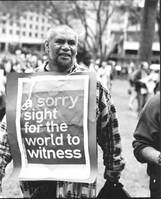 The policy of “stealing” Aboriginal children, mostly those with some white blood, was devised in the early 1900s when 12)eugenic theories were widely 13)touted. In Australia, government administrators thought that by bringing mixed-blood Aborigines into the white world, the color could be “14)bred out of them” over a few generations. Meanwhile the fully black population, regarded as 15)irredeemably primitive, was expected to simply die out. The practice was not widely discussed until 1997, when an official inquiry found consistent patterns of physical and sexual abuse of the “stolen” children, of exploitation in the labor market and of social 16)dislocation that led many into 17)alcoholism, violence and early death.
The policy of “stealing” Aboriginal children, mostly those with some white blood, was devised in the early 1900s when 12)eugenic theories were widely 13)touted. In Australia, government administrators thought that by bringing mixed-blood Aborigines into the white world, the color could be “14)bred out of them” over a few generations. Meanwhile the fully black population, regarded as 15)irredeemably primitive, was expected to simply die out. The practice was not widely discussed until 1997, when an official inquiry found consistent patterns of physical and sexual abuse of the “stolen” children, of exploitation in the labor market and of social 16)dislocation that led many into 17)alcoholism, violence and early death.
Roach, who was taken from his family because he had a white grandfather, knows what they went through. His third set of 18)foster parents treated him well, as an equal to their own three children. But his life was shattered when Roach, 14, received a letter from his sister Myrtle, who had tracked him down through welfare agencies. Their mother, supposedly dead, had passed away the previous week. Furious that he’d been lied to his whole life, Roach ran away from home and spent the next 14 years drinking, sleeping in parks, playing the guitar to earn enough for the next bottle. Finally, he 19)dried out and began writing and singing songs, including his 1987 hit, Took the Children Away, which launched him on an upward musical career. But, he says, “I still feel the pain, every day. Sometimes it threatens to 20)engulf me.”
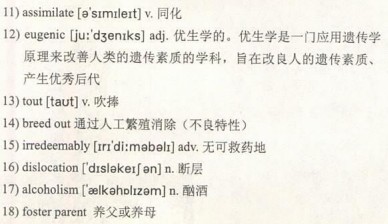
“偷走”土著儿童(主要是那些带有白人血统的)的政策是在20世纪之初、优生学理论广受吹捧时制定推行的。澳大利亚政府相信把这些混血的土著居民带进白人世界,经过几代的“混血”,他们原本的肤色就会褪去。而肤色为全黑的种族则被认为是无可救药地原始低下,就只能等着渐渐消亡。1997年,一份官方调查发现这些被“偷走”儿童,一直面对着被虐打、性虐待这些问题,同时,由于在劳动市场上备受剥削压榨,与社会格格不入,他们中许多人从而酗酒成性,变得暴力,短命早逝。至此,这项政策才得到广泛讨论。
罗奇了解他们所经历的一切;当年他被带走就是因为他祖父是白人。他的第三对养父母对他很好,视如己出。可是,他的生活就在14岁那一年因妹妹美特尔的一封来信而变得支离破碎。美特尔通过福利机构一路追踪找到罗奇。他们“早已去世”的母亲其实一周前才离世。罗奇这才知道自己原来一直被骗,他气愤难当,离家出走。接下来的14年,他露宿公园,靠酒精度日,弹吉他赚钱续杯。后来,他戒了酒,开始写歌、唱歌。1987年,他的一曲《把孩子带走》大热,这也让他的音乐事业节节攀升。但是,他说:“我每日依然感到伤痛。有时,这种痛苦快要把我吞没。”
Dr Jane McKendrick, a 21)psychiatrist at Melbourne University who has worked with Aboriginal communities for 17 years, says a ‘high proportion’ of people from the Stolen Generations were either psychologically, physically or sexually abused while in care. Feelings of depression, anxiety, 22)posttraumatic stress and suicide are commonplace among victims. She notes that 50% of deaths investigated by the Royal Commission into Aboriginal Deaths in 23)Custody were of people who have been removed from their families as children.
Many Aboriginal and 24)Torres Strait Islander people who were placed with white families did not find out about their background until late in life. Finding their 25)estranged families and returning to their birthplace can be the start of a painful process 26)marred by feelings of cultural alienation. One of the people interviewed for the Bringing Them Home Report said: “A lot of people say that they don’t know what exactly they are, whether they’re white or they’re black. Where exactly they belong.”
The impact of the Stolen Generations has also passed on to the next generation. Dr McKendrick reported that “when (Aboriginal people who were removed) come to have their own children they’ve really got no idea how to parent in either the conventional Aboriginal or non-Aboriginal way…so their children are very often removed from them (by welfare agencies) which sets up this terrible cycle which goes on for generations.”
While many Aboriginal groups feel they can never be adequately compensated for the loss of their families, since the Bringing Them Home Report was released there has been a strong campaign for an official apology by the Australian Government. One of the key recommendations of the Bringing Them Home Report was an official apology from the government, as well as financial compensation for the suffering caused by the government. The project aimed to “civilize” Aboriginal children. However, the pain brought by the so called “civilization plan” would last forever.
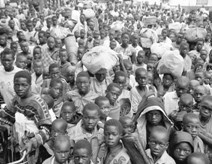
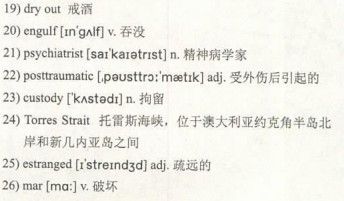
简·麦肯德里克博士是墨尔本大学的精神病学家,她在土著居民社群中工作了17年了,她说“被偷走的一代”中有“相当大一部分”人在寄居期间曾受到身心或性虐待。抑郁、焦虑、受外伤后引起的压力和自杀现象在受害者当中非常普遍。她指出,据皇家委员会的《羁押期间死亡之土著居民》专案调查显示,50%的死者是那些儿童时期就被从父母身边带走的人。
许多被安置在白人中的土著居民和托雷斯海峡岛民一直到年老才得知自己的身世。找寻和自己关系疏远的家人、回到自己的出生地对他们来说是一趟痛苦的旅程,这个过程纠结着他们对土著文化的疏离感。在《带他们回家》报告书中,其中一位受访者说:“很多人说他们不知道自己到底是什么人,是白人还是黑人,不知道到底哪里才是自己的归宿。”
这项政策在“被偷走的一代”身上造成的影响传递到了下一代。麦肯德里克博士说到“被带走的土著居民,当他们有了自己的孩子,他们真的不知道该用哪种方式抚养下一代,是采用传统的土著居民的方式还是非土著居民方式……因此,他们的孩子常常被(福利机构)带走,就这样在一代又一代人之中恶性地循环。
虽然许多原住民都认为任何补偿都无法弥补他们失去家人之痛,然而报告书《带他们回家》的出版仍引起了一场声势浩大的运动——要求澳大利亚政府官方致歉。除了要求政府赔偿经济损失外,这份报告其中一个重要提议就是政府要正式地道歉。那项计划本来为的是“教化”土著儿童。然而,那所谓“文明计划”所带来的创伤却是永远都无法愈合的。
